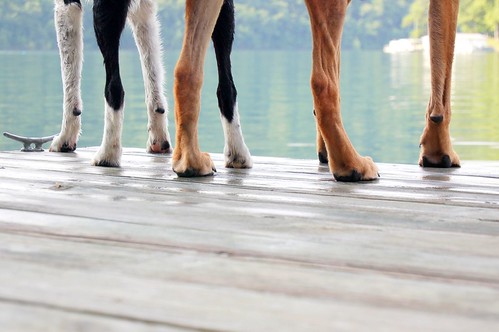1. Use Doggy Sunscreen. As always prevention is better then having to search for a remedy. Dogs can become sunburned and develop skin cancer from access sun exposure. Prevent your pup from becoming a burnt hot dog from the scotching damaging sun rays or skin cancer patient by applying sunscreen protection. If you and your dog are going to be outside during peak sunlight hours make sure to apply a non-toxic doggy specific sunscreen with an SPF of 15 or higher. Apply the sunscreen to exposed & sensitive areas prone to get sunburned such as the tips of ears, bridge of the nose, groin area, inside the legs and underbelly. When choosing the proper sunscreen for your pup make sure to read the ingredient label carefully. Although we advise you to use dog sunscreen, if you use human sunscreen make sure to avoid sunscreen which contain PABA or zinc, dangerous and toxic to your dog if ingested or licked. Baby sunscreen is also another safe alternative.
2. Retreat to Shade. Provide proper shelter by keeping your dog inside, in the shade or under a beach umbrella even on overcast days, during peak direct sunlight hours from 10 am and 3 pm.
3. UV Sun suits . You can help to keep your dog safe by putting him or her in sun suits with UV protection bodysuit. Designed specifically to block out the harmful rays and come in all sizes.
4. Cool Down with a Cool Bath. Give your dog a 20-minute cool water bath if your dog soaks up to much sun. For a soothing solution add oatmeal or baking soda to the bath water to ease the pain and itching caused by sunburn.
5. Treat with all natural Witchhazel. Wipe the sunburned areas with Witchhazel once your dog has been bath. Witchhazel is a natural antioxidant and astringent and can cool down sunburn and inflamed areas. Simply use a cotton ball and apply witch hazel to affected areas several times a day.
6. Cheers for Aloe Vera! Apply a 100% pure Aloe Vera gel to your pups sunburn spots, it is safe and non-toxic.
7. Severe burns need antibiotics. If your dog has severe burns or open sores gently apply an antibiotic ointment. For very severe burns always consult your vet immediately.
8. Vitamin E for sunburned nose. Break open a vitamin E capsule, squeeze out the oil, and dab it onto your dogs sunburned nose once or twice a day. Vitamin E is an antioxidant with healing properties and can prevent scarring of your dogs snout.
9. Keep re-applying sunburn remedies. It is important that the sunburn is healed properly.Re-apply the witchhazel, aloe, vitamin E and antibiotic as needed until your dog is “A” okay.
Suncream prodycts and Eye wear products available from www.scruffmacduff.co.uk
Article by: fidofriendly.com






